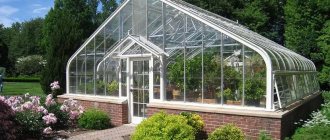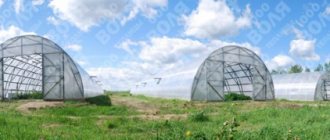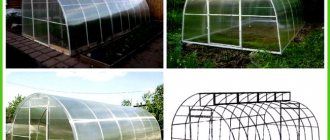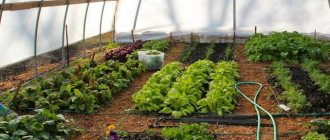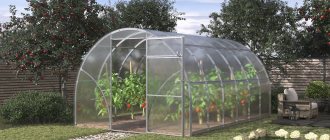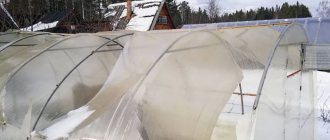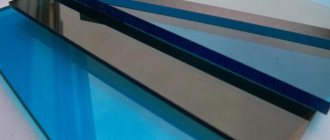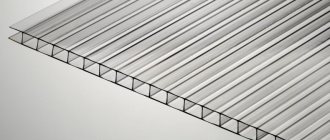Beginning summer residents are convinced that greenhouse plants receive all the conditions for favorable active growth. However, in reality they require no less attention than their “brothers” from the open ground. The microclimate in greenhouses needs to be controlled and adjusted, so agronomists have to monitor basic indicators - humidity and temperature. In particular, in the summer, situations often arise when the greenhouse needs to be darkened.
Due to the scorching rays of the sun, the leaves of the bushes wither or get burned, the soil dries out, and the growth of agricultural crops stops. And this is not the saddest scenario yet. However, you shouldn’t be upset - you can always shade the greenhouse using improvised or purchased products. Find out how to do this in our article.
Ventilation
Photo – Janna Barabash
The easiest way to normalize the temperature in a greenhouse is ventilation. However, often the windows, even if they are installed not only at opposite ends, but also near the ceiling, do not cope with this task. This is where a special cooling system comes to the rescue - fans with temperature sensors.
Install two fans in the greenhouse. Place one at the entrance, at the bottom of the greenhouse; the second is on the opposite side, at the top. The fan at the entrance works to draw air from the street, and the one located at the exit works to remove hot air from the room. When the set temperature is exceeded (for example, above 30°C), the sensors are triggered and the fans start working. When its level drops to normal, they stop. This is how the temperature inside the greenhouse is constantly regulated. The power of the fans should depend on the volume of air they need to pump, and therefore on the size of the greenhouse.
Installing fans is one of the most effective ways to reduce the temperature under polycarbonate. However, it has a serious disadvantage , due to which only a few summer residents can afford such a pleasure - the cost of the equipment itself and the cost of electricity.
How and with what to shade polycarbonate from the sun - advice from tomato growers
Adding an article to a new collection
Many people have learned to protect a greenhouse from cold and return frosts. However, in the summer, greenhouse owners often face a new problem - protecting plants from excessively high temperatures. How to do this effectively?
High temperatures are not only dangerous for poor plant growth. At a constant temperature above 28°C, tomatoes do not set fruit. And if there are no fruits, there is no harvest. How to help plants and reduce the temperature in a greenhouse?
Shading mesh
Photo on the right – Choco Choco
Shading mesh is a gradually gaining popularity as a means of protecting polycarbonate greenhouses from the sun. This mesh can be made of different synthetic materials. However, regardless of the composition, it has one necessary quality - it reduces the amount of light entering the greenhouse. This happens due to the reflection of part of the sun's rays. The greenhouse creates soft diffused light, which is sufficient for photosynthesis to occur. Due to a decrease in the intensity of the light flux, the air temperature inside the greenhouse decreases.
The degree of shading for different types of mesh ranges from 15 to 90%: the higher it is, the less light will enter the greenhouse. For light-loving crops, such as watermelons and melons, material with the least degree of shading is sufficient. But peppers, tomatoes or eggplants need a denser option that allows less sunlight to pass through. Most often, summer residents choose the middle option - with a degree of shading of 45-50%.
According to the instructions, there should be a gap of 20-50 cm between the mesh and the greenhouse. However, most summer residents simply throw the mesh over the greenhouse and fix it. This can be done using plastic bottles, stones or any other weights. Throw the net over the greenhouse. Tie a weight to each end (or attach it to a clip if it came with the mesh) that will securely fix the protective material. Now no wind is afraid of him. If cloudy days come, you can easily remove the cover from the greenhouse in just a few minutes.
The shading mesh has only one significant drawback - its price. However, taking into account the durability of the material (its service life is 5-10 years), it is not much more expensive than the annual purchase of cheaper materials. And in comparison with ventilation, it also turns out to be much more profitable.
Foundation arrangement
There are no particular difficulties in building polycarbonate greenhouses with your own hands due to the light weight of the sheets and the possibility of laying a light base. Standard panels weigh no more than 10 kg, so the foundation can be:
- Boxes made of timber or boards. If coated with protective impregnation, it will last up to 6 years, after which it will require repair or complete replacement.
- Foundation blocks. A more durable, but also expensive option.
- Tape design. Increases the duration of greenhouse installation, but provides the best result in terms of price, reliability and service life.
The strip base can be protected from freezing by insulating it on both sides with sheets of foam plastic and waterproofing the walls with ordinary roofing felt. Also in this case, protection against underground pests is provided. When arranging such a foundation, a depth of 0.6-0.7 m and a width of up to 0.3 m is sufficient. Assembling a polycarbonate greenhouse on this foundation will allow you to obtain the highest thermal efficiency coefficient.
Frame installation
Depending on the size and type of structure, materials such as galvanized steel, wood, PVC and other plastics, as well as combinations thereof, are used. If you have a ready-made greenhouse building on a wooden base, you can simply remove the old covering, renew the protective impregnation and make the cladding from polycarbonate sheets. Wood is a material that can be easily processed, so on its basis you can quickly create greenhouses of any configuration (arched type, gable, etc.). How to assemble a polycarbonate greenhouse based on a metal profile? Typically, galvanized steel is used for this, although in this case additional protection against rust is necessary, because there is always a high level of humidity in the greenhouse room. Metal and wood are increasingly being replaced by plastic. For example, PVC pipes are absolutely not subject to corrosion and rotting processes. They are characterized by good strength, light weight and flexibility, which greatly simplifies the construction of arched buildings. In addition, they can be used in parallel for arranging water supply and heating systems.
The production of a greenhouse frame begins with the preparation of all elements. For the accuracy and correctness of the geometry of the arches, a template is made. The best option is a semicircular shape, but other solutions are possible depending on the location of the building and the personal preferences of the user. Each frame structure has some differences in the matter of installation, but in general the diagram of how to install a polycarbonate greenhouse is as follows:
- fastening a profile or beam along the entire perimeter of the foundation using self-tapping screws (this element acts as a connecting link between the base and parts of the frame);
- marking the installation sites of the arches and fixing them with self-tapping screws;
- installation of vertical supports as new sections are formed and their connection by transverse and longitudinal elements (the number of supports is calculated in accordance with the expected snow loads);
- making openings at the ends of the frame for doors and ventilation holes.
The material is produced in white and black. The black version is used for mulching, as well as for insulation and protection from plant pests.
Covering material
Photo by Anna Panina and Marina Zaitseva
The most common way to shade a polycarbonate greenhouse is to use a covering material. There are two options here: buy it or take what is at hand.
Option 1 – buy covering material
To shade the greenhouse from the scorching sun, use spunbond or any white agrofibre. The density of the material can be from 17 to 23 g/sq.m. Most often, spunbond is stretched inside the greenhouse. In this case, it protects the plantings not only from the sun, but also from condensation that occurs on the roof of the greenhouse and provokes the development of fungal diseases in plants.
Some summer residents from hot regions use covering material together with a shading mesh: a not very dense spunbond is stretched inside, and a mesh is thrown over the outside of the greenhouse.
- Spunbond - how to choose and use agrofibre correctly
We choose the appropriate agrofibre to protect plants from frost, hail, insects, birds and weeds.
Option 2 - use improvised materials for shelter
There can be a great many options here. When choosing, you should consider the following points: the material should be white and not very dense, because... our goal is to reduce the amount of sunlight, and not to deprive the plants of light altogether. Usually, summer residents use old sheets and unnecessary tulle. They can be secured both inside and outside the greenhouse. The easiest way to fix the material inside the structure is this: on the sunny side, closer to the ceiling, stretch a rope along the entire greenhouse; Place the second one under it, near the floor. Now take the prepared fabric and use clothespins to secure it to the top and bottom ropes.
If the available material is not enough, you can combine it with agrofibre: attach agrofibre under the ceiling, and shade the walls with tulle or a sheet.
Historical excursion
Before answering this question, I suggest we go back in time and find out how our distant ancestors dealt with greenhouses, I think this will be interesting information. So, the first greenhouses make us go back to the times of antiquity, namely to ancient Rome, it was there, as historians tell us, that the first structures were discovered that can be attributed to the so-called greenhouses of that time. The gardeners of that time were quite inventive people; they planted different types of vegetables for artificial cultivation in carts on wheels, and took them outside during the day, and brought them into warm rooms at night, thereby fighting the cold in this way, since there were no heaters then.
But over time they managed to cope with this too. In order not to have to carry carts back and forth every time, so-called greenhouses were invented, which were ordinary horse manure, which was laid on top of beds with plants, thereby creating a steam effect when heating this very manure. But this did not save us from severe frosts, because the manure simply could not warm up in the terrible cold, and then our ancestors came to a brilliant discovery, they simply covered the whole thing with a simple structure that resembled a cap, thereby practically recreating our a modern greenhouse, thanks to this they got an excellent way to grow various exotic plants, which, with the next conquest of new lands by the great Roman Empire, were delivered to Rome itself.
Unfortunately, when the Roman Empire collapsed, with it, like much other knowledge in a wide variety of industries, the achievements of these most brilliant gardeners were lost for hundreds of years. Later, when a certain Albert Magnus in the 13th century recreated a greenhouse while creating a winter garden, he was recognized as a sorcerer, and such constructions were prohibited by the Inquisition itself. Greenhouses with all their ensuing incarnations into various winter gardens and greenhouses were revived only during the Renaissance, and were called the “House of Pomeranians.” Greenhouses reached the Russian Empire only at the end of the 16th century.
Greenhouse painting
Transparent polycarbonate allows sunlight to enter the greenhouse, which increases the temperature to levels dangerous for plants. To deprive the material of this negative property in hot summers, the walls of the greenhouse can be whitened. The white color reflects the rays of the sun, so the air inside the building does not heat up as much. You need to choose a substance that can be easily washed off with water.
How you can paint a greenhouse to protect it from the sun:
1. Lime. This is one of the simplest options. After whitewashing the garden, many summer residents have lime left over. Dilute 2-3 kg of powder in 10 liters of water, strain and spray the greenhouse with a spray bottle. If you don't have a sprayer, you can use a brush to whitewash the trees, but the applied layer should be thin.
2. Chalk. Prepare 2 kg of dry chalk, 400 ml of milk and 10 liters of water. Combine all ingredients and stir thoroughly. Then proceed in the same way as with lime. Both lime and chalk are suitable for use both inside and outside the greenhouse. However, keep in mind that when painting interiors, the soil becomes alkalized after they are washed off. This is good if your soil is acidic, but bad if your soil pH is above 7.
3. Water-based or acrylic paints. The greenhouse is only shaded from the outside with paints. Before work, dilute them with water in a ratio of 1 liter of paint per 10 liters of water.
The disadvantage of this method of shading a greenhouse is that after each rain the walls will have to be painted again, because... Most materials are easily washed off with water.
When using chalk or lime inside the greenhouse, be sure to cover the plants so as not to stain them.
What products can be used to darken
The darkening of the greenhouse itself comes down to the formation of a protective shading filter. In fact, it can be any fabric that prevents sunlight from penetrating into the interior space. However, special tools are still required to ensure optimal microclimatic conditions. On the one hand, they will be able to shade the greenhouse. On the other hand, the required level of lighting will still be maintained. And this is extremely important, because for the process of photosynthesis the presence of light is a prerequisite.
Most often, gardeners use the following tools for darkening:
- Special protective mesh;
- Covering material;
- Whitewashing polycarbonate.
Covering material is a good way to physically limit exposure to sunlight. However, the problem with its use comes down to excessive heat accumulation. Accordingly, protecting plants from light and sunburn can significantly overheat the interior of the greenhouse. As a result, the soil will dry out and the crops grown will wither.
Whitewashing a polycarbonate coating is an even less useful and effective method of shading. Of course, the sun will heat up significantly less if you apply a protective layer of paint. For this, by the way, you can use the classic version with slaked lime, a composition of chalk and milk, or any white water-based paint. However, such a coating will not be able to last long - it will simply be washed away by rain. In addition, this is not the most useful procedure for the polycarbonate itself. The protective film may be damaged or the honeycomb of sheets may become dirty.
Some agronomists, in order to shade the greenhouse in the summer, install regular blinds inside. The method is effective, but it definitely cannot be called economical - it turns out to be expensive. It is much more profitable to use a special protective net.
Earth or clay mixture
Not everyone knows, but you can also paint, or rather, cover, walls with what is literally under your feet - earth or clay. Take half a bucket of clay or earth, fill it with water and leave it to swell. After this, add water to the top and coat the outside of the greenhouse with the resulting mass. This can be done conveniently with a roller on the handle or with your hands (bottom).
Like covering with improvised materials, this method of shading a polycarbonate greenhouse does not require any financial investment and is always available. However, be careful: small pebbles or debris that may be in the ground will leave scratches on the surface of the polycarbonate. To prevent this from happening, clear the ground of sharp particles. Difficult? But it's free!
Soil composition
On overly soft soils, the greenhouse structure sags and tilts. The strength of the constituent elements decreases, which causes deformations and cracks. It may also be difficult to open doors and vents for ventilation. It is better to place the greenhouse in an area with fairly dense soil, otherwise an additional foundation will be placed under it. Clay soils are not the best option for a greenhouse. When watered, they retain moisture for a long time, and such an environment is destructive for most crops. The optimal soil composition would be one in which the fertile area alternates with a sandy layer. You can create such conditions yourself. To do this, you need to completely remove the clay layer, make high-quality drainage, and then pour a layer of sand and fertile soil on top.
- Russian-made reinforced film with fishing line is quite durable and holds wind and snow loads well.
- It’s better not to take the Korean one (with fiber inside) - it’s not as reliable as ours.
Plant protection
Another way to shade a polycarbonate greenhouse is to plant tall plants on the sunny side. Most often, gardeners use vines, which grow quickly and create a real green wall. Before planting, take care of plant support. Don't forget to also leave some distance between the greenhouse and the plantings.
- 11 plants that will disguise an unsightly fence and significantly transform the area
Review of popular climbing plants and the secrets of their cultivation.
How do you protect your greenhouse from the sun?
The dangers of shading a greenhouse from the sun: the best materials and methods of covering in the heat
Polycarbonate is a popular material used for the construction of greenhouses. It is convenient to use and easily accessible, but it quickly heats up in the sun, creating too harsh conditions for the plants inside. Experienced gardeners know the solution to this problem. The easiest and cheapest way is to shade a polycarbonate greenhouse from the sun with special lightweight nets.
